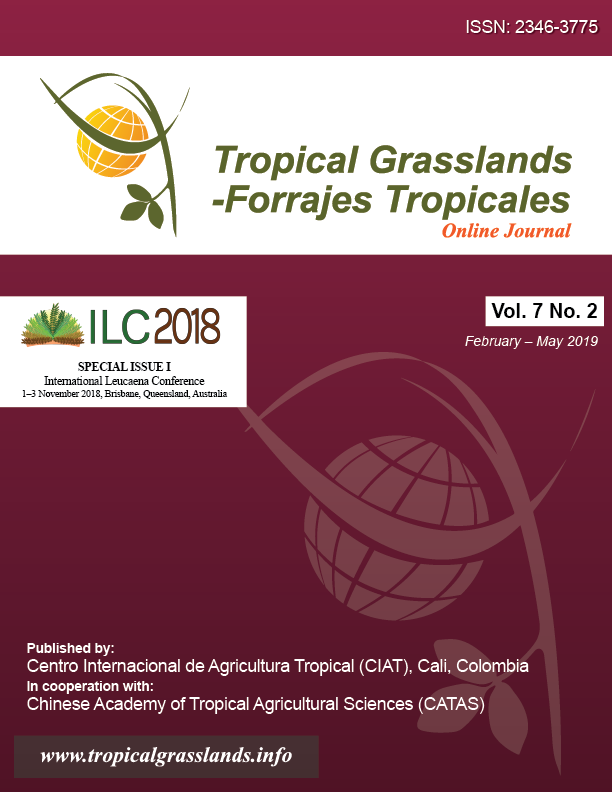Leucaena cultivars – current releases and future opportunities
DOI:
https://doi.org/10.17138/tgft(7)56-64Abstract
Plenary paper presented at the International Leucaena Conference, 1‒3 November 2018, Brisbane, Queensland, Australia.
The Leucaena genus is made up of 24 different species (19 diploid and 5 tetraploid species). However, early use of the Leucaena genus in commercial agricultural systems was based entirely upon a very narrow germplasm base. A single genotype of Leucaena leucocephala ssp. leucocephala (‘common’ leucaena) was spread pantropically from its center of origin in Mexico over 400 years ago. Genetic improvement of Leucaena leucocephala began in the 1950s, when vigorous ‘giant’ leucaena (L. leucocephala ssp. glabrata) was identified in Australia and Hawaii. Cultivars such as Hawaiian Giant K8, Peru and El Salvador were selected and promoted for grazing in Australia and multipurpose agroforestry uses throughout the tropics. Plant breeding for improved forage production resulted in the release of cv. Cunningham in 1976 in Australia. These cultivars of ‘giant’ Leucaena leucocephala displayed broad environmental adaptability, with the exception of poor tolerance of cold temperatures (and frost) and acid soils. The outbreak of the psyllid insect pest (Heteropsylla cubana) from Cuba during the 1980s devastated both ‘common’ and ‘giant’ leucaena all around the world. This challenge resulted in renewed interest in lesser-known Leucaena spp. that exhibited tolerance to the pest and in interspecific hybridization as a means of developing new cultivars. Some ‘giant’ leucaena lines exhibited excellent agronomic traits and a degree of tolerance to the psyllid pest and this resulted in the release of new cultivars in Australia (cvv. Tarramba and Wondergraze) and Hawaii (cv. LxL). Since the 1990s, plant breeding programs have sought to develop cultivars with greater psyllid tolerance using interspecific hybridization. This has resulted in the release of cv. ‘KX2-Hawaii’ for timber and forage production, and a backcrossed forage cultivar cv. Redlands (Australia). Both cultivars are based upon interspecific hybridization between L. pallida and L. leucocephala ssp. glabrata. Cold-temperature and acid-soil tolerance have been pursued in South American breeding programs based upon L. diversifolia, without commercial success. The development of sterile Leucaena spp. cultivars is currently underway to nullify the environmental weed potential of all current commercial cultivars. Tolerance to cold temperatures (L. diversifolia, L. pallida, L. pulverulenta and L. trichandra), frost (L. greggii and L. retusa) and psyllids (L. collinsii) exists within the Leucaena genus and may be exploited in future hybridization programs. New genetic analyses and molecular plant breeding techniques have the potential to facilitate further gene transfer between Leucaena spp. for the development of the next generation of multipurpose cultivars.




